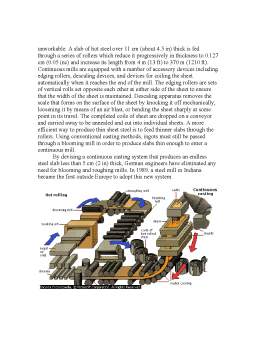Extras din referat
Iron and Steel Manufacture
I. INTRODUCTION:
Iron and Steel Manufacture, technology related to the production of iron and its alloys, particularly those containing a small percentage of carbon. The differences between the various types of iron and steel are sometimes confusing because of the nomenclature used. Steel in general is an alloy of iron and carbon, often with an admixture of other elements. Some alloys that are commercially called irons contain more carbon than commercial steels. Open-hearth iron and wrought iron contain only a few hundredths of 1 percent of carbon. Steels of various types contain from 0.04 percent to 2.25 percent of carbon. Cast iron, malleable cast iron, and pig iron contain amounts of carbon varying from 2 to 4 percent. A special form of malleable iron, containing virtually no carbon, is known as white-heart malleable iron. A special group of iron alloys, known as ferroalloys, is used in the manufacture of iron and steel alloys; they contain from 20 to 80 percent of an alloying element, such as manganese, silicon, or chromium.
II. HISTORY:
The exact date at which people discovered the technique of smelting iron ore to produce usable metal is not known. The earliest iron implements discovered by archaeologists in Egypt date from about 3000 bc, and iron ornaments were used even earlier; the comparatively advanced technique of hardening iron weapons by heat treatment was known to the Greeks about 1000 BC.
The alloys produced by early iron workers, and, indeed, all the iron alloys made until about the 14th century ad, would be classified today as wrought iron. They were made by heating a mass of iron ore and charcoal in a forge or furnace having a forced draft. Under this treatment the ore was reduced to the sponge of metallic iron filled with a slag composed of metallic impurities and charcoal ash. This sponge of iron was removed from the furnace while still incandescent and beaten with heavy sledges to drive out the slag and to weld and consolidate the iron. The iron produced under these conditions usually contained about 3 percent of slag particles and 0.1 percent of other impurities. Occasionally this technique of ironmaking produced, by accident, a true steel rather than wrought iron. Ironworkers learned to make steel by heating wrought iron and charcoal in clay boxes for a period of several days. By this process the iron absorbed enough carbon to become a true steel.
After the 14th century the furnaces used in smelting were increased in size, and increased draft was used to force the combustion gases through the “charge,” the mixture of raw materials. In these larger furnaces, the iron ore in the upper part of the furnace was first reduced to metallic iron and then took on more carbon as a result of the gases forced through it by the blast. The product of these furnaces was pig iron, an alloy that melts at a lower temperature than steel or wrought iron. Pig iron (so called because it was usually cast in stubby, round ingots known as pigs) was then further refined to make steel.
Modern steelmaking employs blast furnaces that are merely refinements of the furnaces used by the old ironworkers. The process of refining molten iron with blasts of air was accomplished by the British inventor Sir Henry Bessemer who developed the Bessemer furnace, or converter, in 1855. Since the 1960s, several so-called minimills have been producing steel from scrap metal in electric furnaces. Such mills are an important component of total U.S. steel production. The giant steel mills remain essential for the production of steel from iron ore.
Preview document
Conținut arhivă zip
- Iron and Steel Manufacture.doc





























